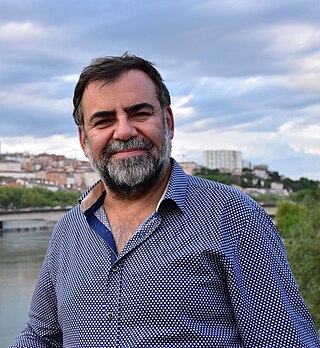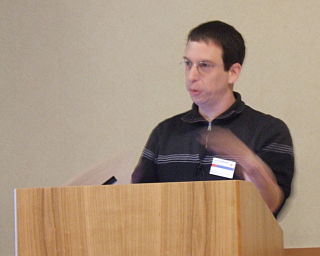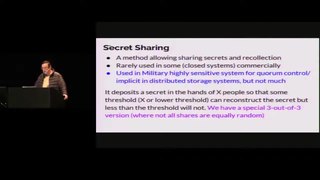Related Research Articles

Diffie–Hellman key exchange is a mathematical method of securely exchanging cryptographic keys over a public channel and was one of the first public-key protocols as conceived by Ralph Merkle and named after Whitfield Diffie and Martin Hellman. DH is one of the earliest practical examples of public key exchange implemented within the field of cryptography. Published in 1976 by Diffie and Hellman, this is the earliest publicly known work that proposed the idea of a private key and a corresponding public key.

Public-key cryptography, or asymmetric cryptography, is the field of cryptographic systems that use pairs of related keys. Each key pair consists of a public key and a corresponding private key. Key pairs are generated with cryptographic algorithms based on mathematical problems termed one-way functions. Security of public-key cryptography depends on keeping the private key secret; the public key can be openly distributed without compromising security.

Ralph C. Merkle is an American computer scientist and mathematician. He is one of the inventors of public-key cryptography, the inventor of cryptographic hashing, and more recently a researcher and speaker on cryonics.

Ronald Linn Rivest is a cryptographer and computer scientist whose work has spanned the fields of algorithms and combinatorics, cryptography, machine learning, and election integrity. He is an Institute Professor at the Massachusetts Institute of Technology (MIT), and a member of MIT's Department of Electrical Engineering and Computer Science and its Computer Science and Artificial Intelligence Laboratory.
Scott A. Vanstone was a mathematician and cryptographer in the University of Waterloo Faculty of Mathematics. He was a member of the school's Centre for Applied Cryptographic Research, and was also a founder of the cybersecurity company Certicom. He received his PhD in 1974 at the University of Waterloo, and for about a decade worked principally in combinatorial design theory, finite geometry, and finite fields. In the 1980s he started working in cryptography. An early result of Vanstone was an improved algorithm for computing discrete logarithms in binary fields, which inspired Don Coppersmith to develop his famous exp(n^{1/3+ε}) algorithm.

Ian Avrum Goldberg is a cryptographer and cypherpunk. He is best known for breaking Netscape's implementation of SSL, and for his role as chief scientist of Radialpoint, a Canadian software company. Goldberg is currently a professor at the Faculty of Mathematics of the David R. Cheriton School of Computer Science within the University of Waterloo, and the Canada Research Chair in Privacy Enhancing Technologies. He was formerly Tor Project board of directors chairman, and is one of the designers of off the record messaging.
Internet security is a branch of computer security. It encompasses the Internet, browser security, web site security, and network security as it applies to other applications or operating systems as a whole. Its objective is to establish rules and measures to use against attacks over the Internet. The Internet is an inherently insecure channel for information exchange, with high risk of intrusion or fraud, such as phishing, online viruses, trojans, ransomware and worms.
WATFIV, or WATerloo FORTRAN IV, developed at the University of Waterloo, Canada is an implementation of the Fortran computer programming language. It is the successor of WATFOR.
In public-key cryptography, the Station-to-Station (STS) protocol is a cryptographic key agreement scheme. The protocol is based on classic Diffie–Hellman, and provides mutual key and entity authentication. Unlike the classic Diffie–Hellman, which is not secure against a man-in-the-middle attack, this protocol assumes that the parties have signature keys, which are used to sign messages, thereby providing security against man-in-the-middle attacks.

Ricardo A. Baeza-Yates is a Chilean-Catalan-American computer scientist that currently is the Director of Research of the Institute for Experiential AI at Northeastern University in the Silicon Valley campus. He is also part-time professor at Universitat Pompeu Fabra in Barcelona and Universidad de Chile in Santiago. He is an expert member of the Global Partnership on Artificial Intelligence, a member of the Association for Computing Machinery's US Technology Policy Committee as well as IEEE's Ethics Committee.
Alfred Menezes is co-author of several books on cryptography, including the Handbook of Applied Cryptography, and is a professor of mathematics at the University of Waterloo in Canada.

In cryptography, a nonce is an arbitrary number that can be used just once in a cryptographic communication. It is often a random or pseudo-random number issued in an authentication protocol to ensure that old communications cannot be reused in replay attacks. They can also be useful as initialization vectors and in cryptographic hash functions.

Dan Boneh is an Israeli–American professor in applied cryptography and computer security at Stanford University.

Cynthia Dwork is an American computer scientist best known for her contributions to cryptography, distributed computing, and algorithmic fairness. She is one of the inventors of differential privacy and proof-of-work.
The J.W. Graham Medal in Computing and Innovation is an award given annually by the University of Waterloo and the University of Waterloo Faculty of Mathematics to "recognize the leadership and many innovative contributions made to the University of Waterloo, and to the Canadian computer industry." Recipients of this award receive a gold medal and certificate. Recipients are graduates of the University of Waterloo Faculty of Mathematics from business, education, or government.

Mordechai M. "Moti" Yung is a cryptographer and computer scientist known for his work on cryptovirology and kleptography.
Anti-tamper software is software which makes it harder for an attacker to modify it. The measures involved can be passive such as obfuscation to make reverse engineering difficult or active tamper-detection techniques which aim to make a program malfunction or not operate at all if modified. It is essentially tamper resistance implemented in the software domain. It shares certain aspects but also differs from related technologies like copy protection and trusted hardware, though it is often used in combination with them. Anti-tampering technology typically makes the software somewhat larger and also has a performance impact. There are no provably secure software anti-tampering methods; thus, the field is an arms race between attackers and software anti-tampering technologies.
Markus Jakobsson is a computer security researcher, entrepreneur and writer, whose work is focused on the issue of digital security.
In information security, message authentication or data origin authentication is a property that a message has not been modified while in transit and that the receiving party can verify the source of the message.
This is a list of cybersecurity information technology. Cybersecurity is security as it is applied to information technology. This includes all technology that stores, manipulates, or moves data, such as computers, data networks, and all devices connected to or included in networks, such as routers and switches. All information technology devices and facilities need to be secured against intrusion, unauthorized use, and vandalism. Additionally, the users of information technology should be protected from theft of assets, extortion, identity theft, loss of privacy and confidentiality of personal information, malicious mischief, damage to equipment, business process compromise, and the general activity of cybercriminals. The public should be protected against acts of cyberterrorism, such as the compromise or loss of the electric power grid.
References
- ↑ "Recipients of the J.W. Graham Medal". Faculty of Mathematics. University of Waterloo . Retrieved 2 December 2015.
- ↑ Cacm Staff (March 2017), "ACM Recognizes New Fellows", Communications of the ACM , 60 (3): 23, doi:10.1145/3039921, S2CID 31701275
- ↑ "Paul Van Oorschot". awards.acm.org. Retrieved 2018-07-01.